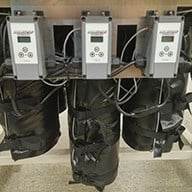In today’s manufacturing world, it is imperative that production processes are not only highly efficient and streamlined but also fail-safe and secure. After all, businesses can’t afford to let equipment failures cost their reputation, business, or employees’ lives.
If a piece of equipment malfunctions, it will affect the entire process or production line. Operators need to shut down the line to make repairs and adjustments. Sometimes, human intervention will be too slow. An emergency shutdown PLC system responds automatically and swiftly in any emergency or hazardous situation. From nuclear power plants to food factories, emergency shutdown systems (ESDs) are in use globally, protecting personnel, facilities, and the environment.
If you run a manufacturing facility, read on to discover everything you need to know about keeping your facility and workers safe with an emergency shutdown system.
What is an Emergency Shutdown PLC System?
There is a difference between an “Emergency Stop” and an “Emergency Shutdown.” An emergency stop is usually a big red button on a piece of equipment or conveyor belt that an operator can push to stop it. An emergency stop usually only controls one piece of equipment. In this example, if the conveyor stops, the product can still pile up on the receiving end.
To shut down the entire production line or process requires an emergency shutdown. An emergency shutdown device will turn off all the equipment in a given process. The PLC (Program Logic Controller) can detect a potentially hazardous condition and shut down all equipment. Programming logic will turn off equipment or valves sequentially, allowing part of the process to depressurize safely before other components can shut down.
For example, in complex operations like an oil refinery or oil platform, hitting the ESD button causes an immediate cascading effect of shutting down all valves, pumps, and processes in a safe sequence of steps. The goal is to minimize the consequences of an emergency, such as flooding, leaking of hazardous materials, or fire.
One way to prevent equipment loss or potential fire hazards is with Temperature-programmable logic controllers. They can automate multiple components of a manufacturing process. Smart temperature control systems can shut down equipment and processes if they exceed their programmed temperature threshold.
Typical PLC installation features a control panel that triggers manually or automatically in dangerous situations. The PLC sends an electrical signal to a safety circuit that activates emergency shut-off devices.
With advanced temperature monitoring capabilities and the ability to integrate seamlessly into existing emergency shutdown systems, Powerblanket’s custom control panels provide an extra layer of protection and control for your facility. Give your team remote access and real-time alerts to potential temperature issues before they become catastrophic.
How Does an Emergency Shutdown PLC System Work?
Before discussing how an emergency shutdown system works, it’s crucial to understand how a programmable logic controller works.
PLCs are computers programmed to control various aspects of industrial processes. They can automatically monitor sensors and switches to ensure each component of the production process is operating as it should. Some examples include running traffic lights, elevators, and amusement park rides. They also control critical and complex industrial processes.
PLC Components…
The two primary components of a PLC are the CPU (Central Processing Unit) and the I/O (Input/Output).
As with any computer, the CPU is the “brain” that handles the data processing and diagnostics. It also includes memory to retain information after the system shuts down.
Smart devices rely on I/O modules to transmit information to the CPU and communicate the required task continuously. Inputs can be switches, and sensors, either analog or digital. Examples of outputs include motor starters, lights, and valves.
…and How they Operate
The PLC functions in a continuous loop, starting with an input scan, which detects all input sensors and connected devices. Next, it executes any pre-programmed functions based on data found during the input. During the output scan, it will start or stop any output devices as required. If there are no abnormal readings, the PLC will continue to monitor as usual.
If the PLC finds an error or fault, such as when a sensor goes off, or a switch is triggered, it will perform a specific action. In this case, engineers designed the PLC system specifically for emergency shutdown functionality.
There are seven primary functions that PLC systems manage during an emergency shutdown, which include:
- Shut down equipment or an entire system
- Isolate electrical equipment to prevent fire and injury
- Ventilation control of a given area
- Stop the flow of hazardous liquids or gases
- Depressurize specific tanks, valves, and pipelines
- Prevent ignition and explosions
- Protect personnel, the facility, and the environment
ESD systems will vary, requiring different shutdown logic depending on the location and processes involved.
For example, if a process operates under high, medium, and low pressure at different points, each condition may require a separate ESD logic to shut down safely.
The Emergency Shutdown system continuously monitors plant safety parameters and takes the appropriate actions as specified in the PLC’s programming.
Benefits of an Emergency Shutdown PLC System
The primary benefit of any emergency shutdown PLC system is safety. Other benefits include:
- Reduced production downtime – When a machine must be shut down because of an unsafe condition, it is essential to react quickly. An E-stop (emergency stop) system ensures that operators can respond as swiftly as possible.
- Faster response times – If a dangerous situation arises and equipment must shut down, but the operator is several feet away, an automated system can react quickly. Also, with an emergency shutdown system, operators can respond from a safe distance.
- More secure production processes – A properly installed and maintained E-stop system ensures a safe work environment where operators, employees, and visitors are not at risk of injury due to machine malfunctions.
Shutdowns can happen manually or automatically by pushing an emergency shutdown button using sensors, valves, and trip relays.
Three Applications of an ESD
The Emergency Shutdown does not need to halt the entire facility. Typically, the PLCs will minimize the effects by shutting down only parts of the process or facility. Here are some examples.
- Nuclear Power Plant
In January 2015, the nuclear power plant in Richland, Washington, experienced an automatic shutdown due to a high-pressure indication. During the shutdown, two control rods failed to insert, and operators had to install them manually.
- Hydrocarbon Inventories’ Isolation System
The PLC ESD system isolates hydrocarbon inventories (oil or gas products) kept in tanks or pipelines during an emergency. Controlling valves and reducing pressure orderly is critical to preventing environmental and potentially fatal disasters.
- Emergency Fire Control System
An Emergency Ventilation system would detect smoke and automatically vent toxic smoke and gases from a confined space in the event of a fire. Additional PLCs could shut down specific plant equipment to help contain the fire, such as closing fire doors and air vents.
Limitations of an Emergency Shutdown PLC System
Although an emergency shutdown PLC system can provide several benefits, it has some constraints, such as:
- Reacts to False Alarms – The ESD system operates in a fail-safe mode which means it will shut down everything as programmed, regardless of the situation, even if it is a false alarm.
- Faulty Sensors – A defective sensor could lead to an unnecessary shutdown of the equipment, which could be costly.
- Low-Voltage Systems – Low-voltage systems use battery power. It could take longer to shut down the machine than with a high-voltage system.
When designing an ESD system, the logic must cover all normal and abnormal configurations, including false alarms, loss of electrical power, hydraulics, etc.
Top Causes of PLC Control System Failure
There are five primary reasons for PLC failures.
1. Input/Output (I/O) Module Failure
The top cause of PLC failure is an issue with input/output modules. If the module fails, the PLC will wait for a signal to continue performing its function.
2. Electromagnetic Interference
Large motors, lightning storms, antennas, and other elements can produce enough electromagnetic noise and radio frequency interference to disrupt the PLC.
3. Loss of Power
Power issues can plague PLC performance. They usually run between 5V and 24V. An uneven power supply from brownouts and power surges to total blackouts can fry PLCs.
4. Corrupted RAM Memory
As with any computer memory or program, it will fail if the code becomes corrupted. It will need to be reprogrammed if possible or replaced if not.
5. Loss of Communication
PLCs must communicate with other connected devices. Typically they use an ethernet cable, but more often are wireless. Anything that interferes with the communication stops the PLC from working.
Each component in an emergency shutdown PLC system should have regularly scheduled testing and maintenance to avoid unnecessary shutdowns. Consider installing an uninterruptible power supply (UPS), programming the PLC with a battery time-out function, or installing a generator system to prevent power supply issues.
What Can Replace PLCs?
Due to the rise in cyberattacks, many industrial organizations are looking to replace their PLC systems with more advanced and secure technology, the Internet of Things (IoT).
IoT is a network of connected devices that can be monitored, controlled, and programmed remotely via the internet in real-time. The devices can include sensors, cameras, and other types of equipment. Industrial organizations can remotely monitor their manufacturing distribution and operations using the IoT. They can also troubleshoot issues remotely, as well as shift resources as needed in the event of an emergency.
While PLCs and the IoT allow for the remote operation of devices, the IoT does so on a larger scale. You can think of it this way, PLCs are hubs that connect to and control all of the equipment in a process. The IoT is a system that connects all of the equipment in a facility.
Another way to reduce dependence on PLCs for temperature control is to use industrial temperature controllers. Operators can check and adjust temperature thresholds remotely. Powerblanket’s heater control panels allow operators to remotely manage temperature variables from the convenience of a smartphone, tablet, or computer. It can also tie into existing ESDs for safety.
Detect Potential Failure With Emergency PLC Shut Down Systems
Today’s PLCs are more flexible and programmable than before, allowing engineers to design systems with the right balance of flexibility and safety.
By now, we know the limits of an emergency shutdown PLC system. It can sometimes lose its programming when there’s no power. Solutions include installing an uninterruptible power supply, programming the PLC with a battery time-out function, or installing a generator system. Some processes are so critical that they require one or two redundant safety-rated PLCs to ensure they won’t fail during an emergency.
The systems can shut down the entire facility to prevent potential injury, damage, or loss if an imminent threat exists, such as a natural disaster or an explosive event.
Emergency shutdown PLC systems have saved lives in nuclear energy plants, petrochemical processing facilities, steam and gas turbine power plants, and anywhere there is a potential fire or explosion hazard. They react much faster than humans, preventing minor problems from becoming catastrophes.
Powerblanket's industrial control solutions give you the power to automate, remotely control, and monitor your valuable materials and equipment.



